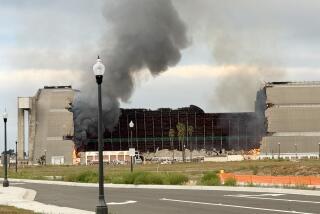Firefighting equipment was sabotaged before San Diego ship blaze, search warrant says

A federal search warrant unsealed Tuesday reveals for the first time the breadth of the early days of the investigation into the devastating fire on board the amphibious assault ship Bonhomme Richard — and how a 19-year-old SEAL dropout became the prime arson suspect.
The records, filed in San Diego federal court by the Naval Criminal Investigative Service, also suggest someone sabotaged the ship’s firefighting equipment before the July 12, 2020, blaze and tampered with crime scene evidence in the days that followed.
Seaman Apprentice Ryan Mays, now 20, was charged Thursday by the Navy with aggravated arson and hazarding of a vessel in connection with the fire. Gary Barthel, a San Diego-based military lawyer who represents Mays, declined to comment on the information in the warrant late Tuesday, saying he hasn’t received any documents in the case yet from Navy prosecutors.
“The warrant is just an affidavit from an [NCIS] agent,” Barthel said. “It’s always possible the evidence will show this warrant was not valid.”
Barthel confirmed that Mays was charged and said he denies any wrongdoing.
“He’s been adamant,” Barthel said. “He denies any involvement with the starting of the fire.”
The U.S. attorney’s office asked a federal judge to unseal the search warrant so it could be disclosed to the sailor’s defense lawyers in the Navy prosecution, according to a motion filed Monday.
The Navy has not confirmed Mays is the sailor charged with starting the fire, although he was named in the search warrant. Cmdr. Sean Robertson, a spokesman for the San Diego-based 3rd Fleet, also declined to comment on the investigation Tuesday.
Mays joined the Navy out of Kentucky and graduated boot camp in July 2019, according to his Navy bio. He completed a Navy SEAL prerequisite school in Illinois and reported to the Basic Underwater Demolition School — commonly called “BUD/S” — at Naval Base Coronado in September 2019. In March 2020, Mays left BUD/S and reported to the Bonhomme Richard as a deck seaman.
Mays is assigned to Amphibious Squadron 5 at Naval Base San Diego.
Although he was briefly held in pretrial confinement at the Navy Consolidated Brig at Marine Corps Air Station Miramar last year, in November he was released and has been performing his regular duties, his lawyer has said.
Before this, Barthel said, Mays had not been in any trouble in the Navy and left BUD/S because of an injury.
The 844-foot Bonhomme Richard was near the end of a two-year, $250-million upgrade to accommodate the F-35B fighter when smoke was reported in its lower vehicle storage area on the morning of July 12, a Sunday.
The area, commonly called the “lower V,” was directly below the ship’s large oxygen-rich well deck. Fueled by abundant supplies of oxygen and combustible material, the fire quickly spread throughout the ship as firefighters struggled to access the blaze because of extreme heat.
It took Navy and federal firefighters four days to fully extinguish the blaze. A month later, the Navy declared the vessel a total loss. It was towed out of San Diego in April to a scrapyard in Brownsville, Texas.
The search warrant was filed in San Diego federal court in September — nearly a year ago — asking for access to Mays’ email and internet accounts. The document notes that the forensic search of his cellphone had not yet been completed. It is unclear how the investigation has proceeded since.
According to the warrant, the Bureau of Alcohol, Tobacco, Firearms and Explosives investigators began their investigation around July 16 last year. The “progression and migration of the fire” and other evidence pointed to arson.
On July 20, 2020, as ATF investigators combed the area closest to where the fire began, they found a plastic bottle with no cap that contained a small amount of liquid. They flagged the bottle as potential evidence, wrapping a piece of neon orange tape around its neck and placing it on top of a spool of rope.
Investigators then left the bottle in place, where crime scene technicians could collect and process it for DNA and fingerprints.
When investigators returned to the scene the next day, the bottle was gone, the search warrant states. The flagging tape that had been attached to it and the knot of rope were discarded on the floor.
No investigators or technicians had processed the bottle or removed the flagging tape, and an exhaustive search of the area came up empty, according to the document. The search did, however, turn up three additional bottles and two aluminum cans, four of which contained small amounts of liquid. The cap to one bottle was melted, while another was partially melted with a hole in its center.
Lab tests confirmed at least one of the bottles contained a heavy petroleum distillate, such as diesel or jet fuel.
Investigators also found expended carbon dioxide cartridges inside a combination washer/dryer machine that appeared to have exploded during the fire, as well as cartridges on top of boxes of hand sanitizer that were inside coils of metal hose line, according to the warrant.
A search of Navy records revealed that during the time frame the initial bottle went missing, Mays’ duty section had been onboard. DNA was found on the flagging tape that was left behind, but analysis confirmed it did not belong to Mays.
A lieutenant commander took investigators on a tour of the firefighting stations in the area, and pointed out that three of the four stations were not set up as they should be, the warrant states. Firefighting hoses were disconnected at some stations, and a hose had been cut at another.
The Navy official told investigators that he or his damage control staff had inspected the area’s fire stations two days before the blaze, and probably would have caught the anomalies. He concluded that three of the stations “appeared to have been purposely tampered with and/or disconnected.”
Investigators questioned numerous sailors on board at the time of the fire, and one described seeing a man wearing clean coveralls and a face mask, carrying a bucket in both hands, descend into the lower V shortly before the fire broke out. The witness at first said he didn’t know who the person was, but later said he suspected it was Mays, according to the search warrant.
He said he didn’t see anyone return from the lower V after the fire; investigators noted there were other exits from the area.
Mays’ lawyer noted Tuesday that sailors on the ship were all wearing masks at the time.
Investigators asked all sailors about the fire in an initial questionnaire. Mays wrote that he was in the hangar bay when he saw black smoke and was the only person to report smelling a “burning fuel/rubbery smell.”
Later, in a 10-hour interview with investigators, Mays said he was cleaning mooring stations when the fire broke out and that he tried to assist in the firefighting effort. He denied starting the fire several times throughout the interview and described being possibly identified by a witness as being a setup, according to the warrant.
A Navy chief told investigators that Mays told him he had been in the lower V the day before the fire to store hoses but that he hadn’t seen anything to indicate the fire had sparked on its own. Mays concluded in the conversation that it was more likely someone had started the fire, according to the warrant.
Dyer and Davis write for the San Diego Union-Tribune.
More to Read
Updates
12:46 p.m. Aug. 4, 2021: This story was updated with new information about a second affidavit unsealed Wednesday.
Start your day right
Sign up for Essential California for news, features and recommendations from the L.A. Times and beyond in your inbox six days a week.
You may occasionally receive promotional content from the Los Angeles Times.







